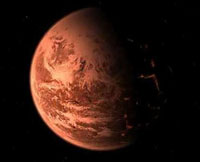 |
| Handout picture
released June 14, 2005 shows an artist's conception of a newly
discovered planet being shown as a hot, rocky, geologically
active world glowing in the deep red light of its nearby
parent star, the M dwarf Gliese 876. The heat and the reddish
light are among the few things about the new planet that are
certain (reuters)
| |
A planet that may be Earth-like - but too hot for life as we know it -
has been discovered orbiting a nearby star.
The discovery of the
planet, with an estimated radius about twice that of Earth, was
announced Monday at the National Science Foundation.
"This is the smallest extrasolar planet yet detected and
the first of a new class of rocky terrestrial planets," Paul Butler of
the Carnegie Institution in Washington said in a statement. "It's like
Earth's bigger cousin."
Geoffrey Marcy, professor of astronomy at the University of California,
Berkeley, added: "Over 2,000 years ago, the Greek philosophers Aristotle
and Epicurus argued about whether there were other Earth-like planets.
Now, for the first time, we have evidence for a rocky planet around a
normal star."
Though the researchers have no direct proof that the new planet is
rocky, its mass means it is not a giant gas planet like Jupiter, they
said. They estimated the planet's mass as 5.9 to 7.5 times that of Earth.
It is orbiting a star called Gliese 876, 15 light years from Earth,
with an orbit time of just 1.94 Earth days. They estimated the surface
temperature on the new planet at between 400 degrees and 750 degrees
Fahrenheit.
Gliese 876 is a small, red star with about one-third the mass of the
sun. The researchers said this is the smallest star around which planets
have been discovered. In addition to the newly found planet the star has
two large gas planets around it.
Butler said the researchers think that the most probable composition of
the planet is similar to inner planets of this solar system - a
nickel/iron rock.
Gregory Laughlin of the Lick Observatory at the University of
California, Santa Cruz, said a planet of this mass could have enough
gravity to hold onto an atmosphere. "It would still be considered a rocky
planet, probably with an iron core and a silicon mantle. It could even
have a dense steamy water layer."
Three other extrasolar planets believed to be of rocky composition have
been reported, but they orbit a pulsar - the flashing corpse of an
exploded star - rather than a normal type of
star.
(Agencies) |
最近,天文学家新发现了一颗类地行星,它围绕着附近的一颗恒星运转。但从已知情况来看,其表面温度太高,不适合生命生存。
美国国家自然科学基金会本周一(6月13日)宣布了这一消息。据估计,这个行星的半径约为地球的两倍。
华盛顿卡耐基学院的保罗·巴特勒声称:“这颗行星是迄今为止人类所发现的最小的太阳系外行星,也是第一颗新型的岩状类地行星。它就像是地球的堂兄。”
加州大学伯克利分校的天文学教授杰弗里·马西补充说:“大约2000多年前,古希腊哲学家亚里斯多德和伊壁鸠鲁就曾经对宇宙中是否存在类地行星展开过激烈辩论。现在,我们第一次有证据表明,宇宙中存在一颗环绕常态恒星运转的岩状行星。”
尽管目前研究人员还没有直接证据证明这是一颗岩状行星,但是他们宣称,这颗行星的质量表明,它并不是一颗类似木星的巨大气体行星。他们估计这颗行星的质量大约是地球的5.9到7.5倍。
这颗行星围绕着一颗名为“格里斯876”的恒星运转,该恒星距地球15光年,绕轨道运行一周的时间约为地球上的1.94天。据研究人员估计,这颗新发现的行星的表面温度介于400至750华氏度之间。
“格里斯876”是一颗小型红色恒星,其质量约为太阳的三分之一。研究人员说,这是目前人类所发现的最小的有行星环绕的恒星。除新发现的这颗行星之外,还有两颗巨大的气体行星围绕着它运转。
巴特勒说,研究人员认为这颗行星的成分极有可能与太阳系内行星类似,由含有镍和铁成份的岩石组成。
格雷戈里·劳福琳在位于加州大学圣克鲁斯分校的利克天文台工作。他断言,具有如此巨大质量的行星必能产生足够的引力,吸引住大气。他说:“我们仍可认为它是一颗岩状行星,其内核可能为铁,表层覆盖着镍,其外层甚至可能笼罩着浓厚的蒸汽状的水。”
之前人们曾报道过另外三颗据信由岩石组成的太阳系外行星,但是,它们是围绕着一颗脉冲星(恒星爆发后遗留的发光的残存物)运转的,而不是一颗常态的恒星。
(中国日报网站译) |
